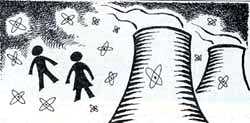Bad blood
Bad blood

Cold start A 10-YEAR old controversy about whether a nuclear reprocessing plant in northwest England was responsible for a high occurrence of leukaemia reported in the area has been finally laid to rest. The English High Court recently ruled that there was not enough evidence to implicate the company -- British Nuclear Fuels -- which operates the plant located at Sellafield. The plant had begun to attract a great deal of attention in 1983 when scientists reported an unusually high incidence of leukaemia in young people below 25 years, living at Seascale, a small town about 3 km from the nuclear plant. Although most experts rejected the idea that local pollution from radioactive waste was responsible for the blood cancer cases, a hypothesis put forward by medical researcher Martin Gardner gained currency. Gardner held that the exposure to radiation of the children's fathers who worked at the plant resulted in genetic changes in their sperm, increasing the risk of leukaemia in their offspring.
This hypothesis even prompted 2 families of children suffering from leukaemia to seek compensation from the company. However, detailed scientific evidence that came to light in the course of the trial has unequivocally disproved what has come to be known as the Gardner hypothesis (Nature, Vol 367, No 6465).
According to R Doll and S C Darby of the Imperial Cancer Research Fund Cancer Units, University of Oxford, and H J Evans of the MRC Human Genetics Unit, Western General Hospital, Edinburgh, the hypothesis is not in concordance with what is known about radiation genetics.
Mutation by radiation
One argument against the beleaguered hypothesis is provided by the known rates of genetic changes or mutations caused by radiation. Data from experimental studies on animals and human survivors of the Hiroshima and Nagasaki atomic explosions indicate that very high doses of radiation would be required to produce the mutations claimed by Gardner. But the actual doses received by the Sellafield workers were far less.
Moreover, a Canadian study of all children under the age of 15 years, who were born near 5 nuclear installations in Ontario, and who had either died of leukaemia or developed the disease, found no relationship between childhood leukaemia and the father's occupation. A similar study in Scotland, and another near 2 nuclear installations in the south of England, also could not provide information to support Gardner's contention.
The most damning evidence, however, was provided by researcher Leo Kinlen who showed that the occurrence of leukaemia was not limited to children born in Seascale, but included those born elsewhere but living in Seascale.
Kinlen provided an alternative explanation for the high incidence of leukaemia in Seascale that is supported by Doll. They suggest that the disease was possibly caused by an unknown infectious agent brought in by the large influx of people into previously remote areas of Cumbria. Although evidence to substantiate this new theory is still lacking, most scientists and the English High Court now contend that the association between paternal radiation exposure and leukaemia appears only to be a chance finding.







